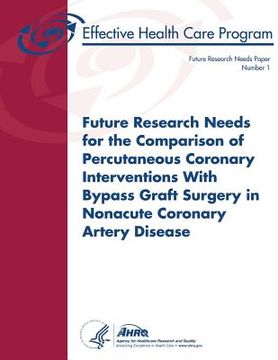Compartir
Future Research Needs for the Comparison of Percutaneous Coronary Interventions with Bypass Graft Surgery in Nonacute Coronary Artery Disease: Future (en Inglés)
U. S. Department of Heal Human Services
(Autor)
·
Agency for Healthcare Resea And Quality
(Autor)
·
Createspace Independent Publishing Platform
· Tapa Blanda
Future Research Needs for the Comparison of Percutaneous Coronary Interventions with Bypass Graft Surgery in Nonacute Coronary Artery Disease: Future (en Inglés) - And Quality, Agency for Healthcare Resea ; Human Services, U. S. Department of Heal
$ 39.901
$ 66.502
Ahorras: $ 26.601
Elige la lista en la que quieres agregar tu producto o crea una nueva lista
✓ Producto agregado correctamente a la lista de deseos.
Ir a Mis Listas
Origen: Estados Unidos
(Costos de importación incluídos en el precio)
Se enviará desde nuestra bodega entre el
Martes 27 de Agosto y el
Jueves 05 de Septiembre.
Lo recibirás en cualquier lugar de Argentina entre 1 y 3 días hábiles luego del envío.
Reseña del libro "Future Research Needs for the Comparison of Percutaneous Coronary Interventions with Bypass Graft Surgery in Nonacute Coronary Artery Disease: Future (en Inglés)"
Percutaneous coronary interventions (PCI) with or without stents and coronary artery bypass graft surgery (CABG) are the two broad categories of interventions for mechanical revascularization of atherosclerotic coronary arteries in patients with coronary artery disease (CAD). The choice of revascularization procedure is often determined by coronary anatomy and the technical feasibility of either PCI or CABG. Therefore the clinical dilemma pertains to patients in whom both procedures are technically feasible and whose coronary disease is neither too limited nor too extensive. Generally, both approaches would be clinically relevant for patients with single-vessel disease of the proximal left anterior descending artery, most types of two-vessel disease, as well as patients with three-vessel disease that is not particularly extensive. Because PCI and CABG differ in their procedural risk and their initial and downstream costs, assessing their comparative effectiveness and safety is of great interest. PCI and CABG have already been compared in several randomized controlled trials (RCTs) and analyses of large clinical registries. The aim of this report is to identify needs for future research in the comparison between PCI and CABG. We use as a basis the 2007 comparative effectiveness report (CER) by the Stanford-University of California at San Francisco Evidence-based Practice Center (Stanford-UCSF EPC) that assessed PCI vs. CABG for coronary artery disease. The report summarized evidence published through 2006 to address the following key questions: Key Question 1a: In patients with ischemic heart disease and angiographically proven single- or multiple-vessel disease, what is the comparative effectiveness of PCI compared to CABG in reducing the occurrence of adverse objective outcomes and improving subjective outcomes? Key Question 1b: Over what period are the comparative benefits of PCI and CABG sustained? Key Question 2: Is there evidence that the comparative effectiveness of PCI and CABG varies based on (predefined) patient and procedure related factors? The Stanford CER includes almost all large RCTs that are available as of this writing. It is therefore a relatively current report. However two limitations should be noted. Medical treatment (no revascularization) is now considered a clinically valid option for many patients with nonacute CAD, but it was not in the scope of the Stanford CER. Therefore the Stanford CER does not represent a full evaluation of the actual clinical options that are available today. Second, several RCTs have published their results after the completion of the Stanford CER and several ongoing RCTs are expected to report results in the next 2 or 3 years. This means that the following evidence gaps identified in the Stanford CER should be assessed in the light of the newer evidence. The identified gaps were: 1. Paucity of published analyses of PCI and CABG outcomes according to patient characteristics. Specifically highlighted subgroups include women, the elderly, patients with chronic kidney disease, and patients with left ventricular dysfunction. 2. Paucity of data on the comparative effectiveness and safety of drug eluting stents (DES) in particular, and especially in the long term. 3. Paucity of data on the relationship between procedural volume and outcomes of minimally invasive approaches to CABG. It cannot be assumed that the relationships defined for standard CABG will apply to minimally invasive CABG. For example, the volume thresholds of minimally invasive CABG may differ, given the differences in the technique. 4. Paucity of data on metrics for quality of care for PCI and CABG procedures.
- 0% (0)
- 0% (0)
- 0% (0)
- 0% (0)
- 0% (0)
Todos los libros de nuestro catálogo son Originales.
El libro está escrito en Inglés.
La encuadernación de esta edición es Tapa Blanda.
✓ Producto agregado correctamente al carro, Ir a Pagar.

